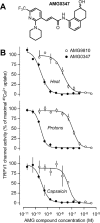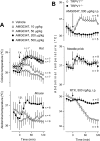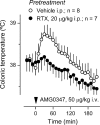Nonthermal activation of transient receptor potential vanilloid-1 channels in abdominal viscera tonically inhibits autonomic cold-defense effectors
- PMID: 17626206
- PMCID: PMC6672610
- DOI: 10.1523/JNEUROSCI.1483-07.2007
Nonthermal activation of transient receptor potential vanilloid-1 channels in abdominal viscera tonically inhibits autonomic cold-defense effectors
Abstract
An involvement of the transient receptor potential vanilloid (TRPV) 1 channel in the regulation of body temperature (T(b)) has not been established decisively. To provide decisive evidence for such an involvement and determine its mechanisms were the aims of the present study. We synthesized a new TRPV1 antagonist, AMG0347 [(E)-N-(7-hydroxy-5,6,7,8-tetrahydronaphthalen-1-yl)-3-(2-(piperidin-1-yl)-6-(trifluoromethyl)pyridin-3-yl)acrylamide], and characterized it in vitro. We then found that this drug is the most potent TRPV1 antagonist known to increase T(b) of rats and mice and showed (by using knock-out mice) that the entire hyperthermic effect of AMG0347 is TRPV1 dependent. AMG0347-induced hyperthermia was brought about by one or both of the two major autonomic cold-defense effector mechanisms (tail-skin vasoconstriction and/or thermogenesis), but it did not involve warmth-seeking behavior. The magnitude of the hyperthermic response depended on neither T(b) nor tail-skin temperature at the time of AMG0347 administration, thus indicating that AMG0347-induced hyperthermia results from blockade of tonic TRPV1 activation by nonthermal factors. AMG0347 was no more effective in causing hyperthermia when administered into the brain (intracerebroventricularly) or spinal cord (intrathecally) than when given systemically (intravenously), which indicates a peripheral site of action. We then established that localized intra-abdominal desensitization of TRPV1 channels with intraperitoneal resiniferatoxin blocks the T(b) response to systemic AMG0347; the extent of desensitization was determined by using a comprehensive battery of functional tests. We conclude that tonic activation of TRPV1 channels in the abdominal viscera by yet unidentified nonthermal factors inhibits skin vasoconstriction and thermogenesis, thus having a suppressive effect on T(b).
Figures





Comment in
-
Thermoregulation: channels that are cool to the core.Curr Biol. 2007 Oct 23;17(20):R885-7. doi: 10.1016/j.cub.2007.08.016. Curr Biol. 2007. PMID: 17956748 Review.
Similar articles
-
Thermoregulatory phenotype of the Trpv1 knockout mouse: thermoeffector dysbalance with hyperkinesis.J Neurosci. 2011 Feb 2;31(5):1721-33. doi: 10.1523/JNEUROSCI.4671-10.2011. J Neurosci. 2011. PMID: 21289181 Free PMC article.
-
Antihyperalgesic effects of (R,E)-N-(2-hydroxy-2,3-dihydro-1H-inden-4-yl)-3-(2-(piperidin-1-yl)-4-(trifluoromethyl)phenyl)-acrylamide (AMG8562), a novel transient receptor potential vanilloid type 1 modulator that does not cause hyperthermia in rats.J Pharmacol Exp Ther. 2008 Jul;326(1):218-29. doi: 10.1124/jpet.107.132233. Epub 2008 Apr 17. J Pharmacol Exp Ther. 2008. PMID: 18420600
-
The vanilloid receptor TRPV1 is tonically activated in vivo and involved in body temperature regulation.J Neurosci. 2007 Mar 28;27(13):3366-74. doi: 10.1523/JNEUROSCI.4833-06.2007. J Neurosci. 2007. PMID: 17392452 Free PMC article.
-
The transient receptor potential vanilloid-1 channel in thermoregulation: a thermosensor it is not.Pharmacol Rev. 2009 Sep;61(3):228-61. doi: 10.1124/pr.109.001263. Epub 2009 Sep 11. Pharmacol Rev. 2009. PMID: 19749171 Free PMC article. Review.
-
Thermoregulation: channels that are cool to the core.Curr Biol. 2007 Oct 23;17(20):R885-7. doi: 10.1016/j.cub.2007.08.016. Curr Biol. 2007. PMID: 17956748 Review.
Cited by
-
Role of TRPV1 and TRPA1 Ion Channels in Inflammatory Bowel Diseases: Potential Therapeutic Targets?Pharmaceuticals (Basel). 2019 Mar 30;12(2):48. doi: 10.3390/ph12020048. Pharmaceuticals (Basel). 2019. PMID: 30935063 Free PMC article. Review.
-
Structure-activity relationships of vanilloid receptor agonists for arteriolar TRPV1.Br J Pharmacol. 2012 Mar;165(6):1801-1812. doi: 10.1111/j.1476-5381.2011.01645.x. Br J Pharmacol. 2012. PMID: 21883148 Free PMC article.
-
Regulation of Body Temperature by the Nervous System.Neuron. 2018 Apr 4;98(1):31-48. doi: 10.1016/j.neuron.2018.02.022. Neuron. 2018. PMID: 29621489 Free PMC article. Review.
-
TRPV1 Channel: A Potential Drug Target for Treating Epilepsy.Curr Neuropharmacol. 2015;13(2):239-47. doi: 10.2174/1570159x13666150216222543. Curr Neuropharmacol. 2015. PMID: 26411767 Free PMC article. Review.
-
Wiring the Brain for Wellness: Sensory Integration in Feeding and Thermogenesis: A Report on Research Supported by Pathway to Stop Diabetes.Diabetes. 2024 Mar 1;73(3):338-347. doi: 10.2337/db23-0706. Diabetes. 2024. PMID: 38377445 Free PMC article. Review.
References
-
- Almeida MC, Steiner AA, Branco LG, Romanovsky AA. Cold-seeking behavior as a thermoregulatory strategy in systemic inflammation. Eur J Neurosci. 2006b;23:3359–3367. - PubMed
-
- Aviado DM, Guevara-Aviado D. The Bezold-Jarisch reflex. A historical perspective of cardiopulmonary reflexes. Ann NY Acad Sci. 2001;940:48–58. - PubMed
Publication types
MeSH terms
Substances
Grants and funding
LinkOut - more resources
Full Text Sources
Other Literature Sources
